Danish Rye Bread (Rugbrød)
This post may contain affiliate links. See my disclosure policy.
This authentic Danish rye bread recipe (rugbrod) is easier to make than you may think. It’s packed with nutrients, has a fantastic texture and old-fashioned flavor and is just plain delicious! Whether you prefer a bolder or milder flavor, you’re completely in charge of that in determining how long you allow the batter to ferment.
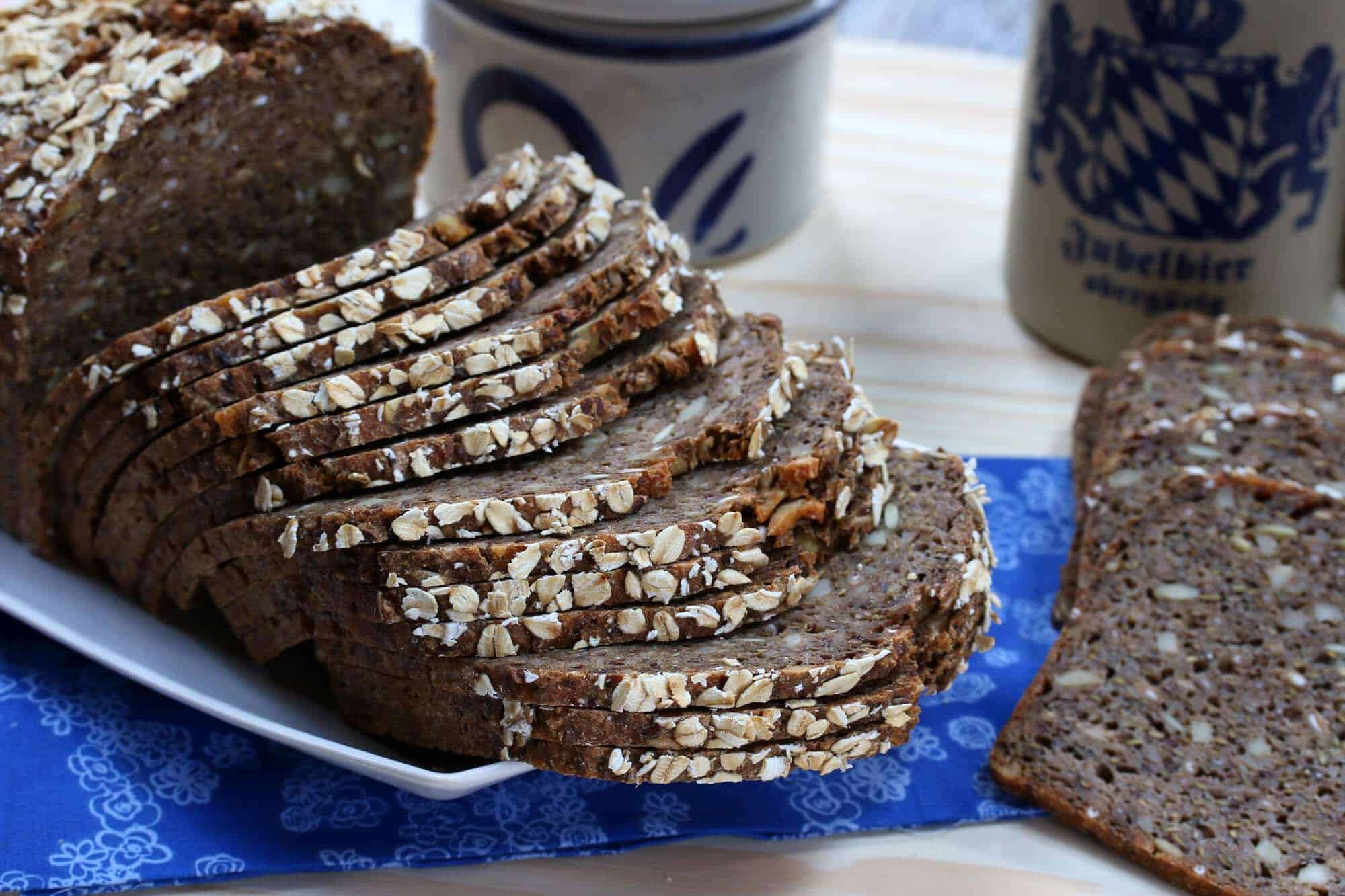
I love breads of all kinds, but there are two kinds that I especially love: Ones that are perfectly crispy on the outside and fluffy on the inside (eg, baguettes) and whole grain breads that are very dense and hearty like the kind I grew up with in Germany (eg, Vollkornbrot, Roggenbrot, Schwarzbrot, etc) and this Danish rye bread.
Smorrebrod
In Germany and throughout Scandinavia dense whole grain breads are particularly popular. You’ll see them served cut up in squares for a variety of hors d’oeuvres (for example, topped with gravlax/smoked salmon, a dollop of crème fraîche or hard-boiled eggs and a sprig of dill), served for breakfast with a tray of sliced cheeses and cold cuts, enjoyed for open-faced sandwiches or simply slathered down with good butter and jam.
In Denmark this rye bread (rugbrød) serves as the basis for their smørrebrød (ie, smorgasbord) wherein it is served buffet style with any number of fine toppings and is also a common accompaniment for many meals. Traditional options include herring, pickled vegetables, liver pate, smoked salmon, and sliced hard-boiled eggs. This Danish Rye Bread recipe is just what you need to create your smorrebrod!
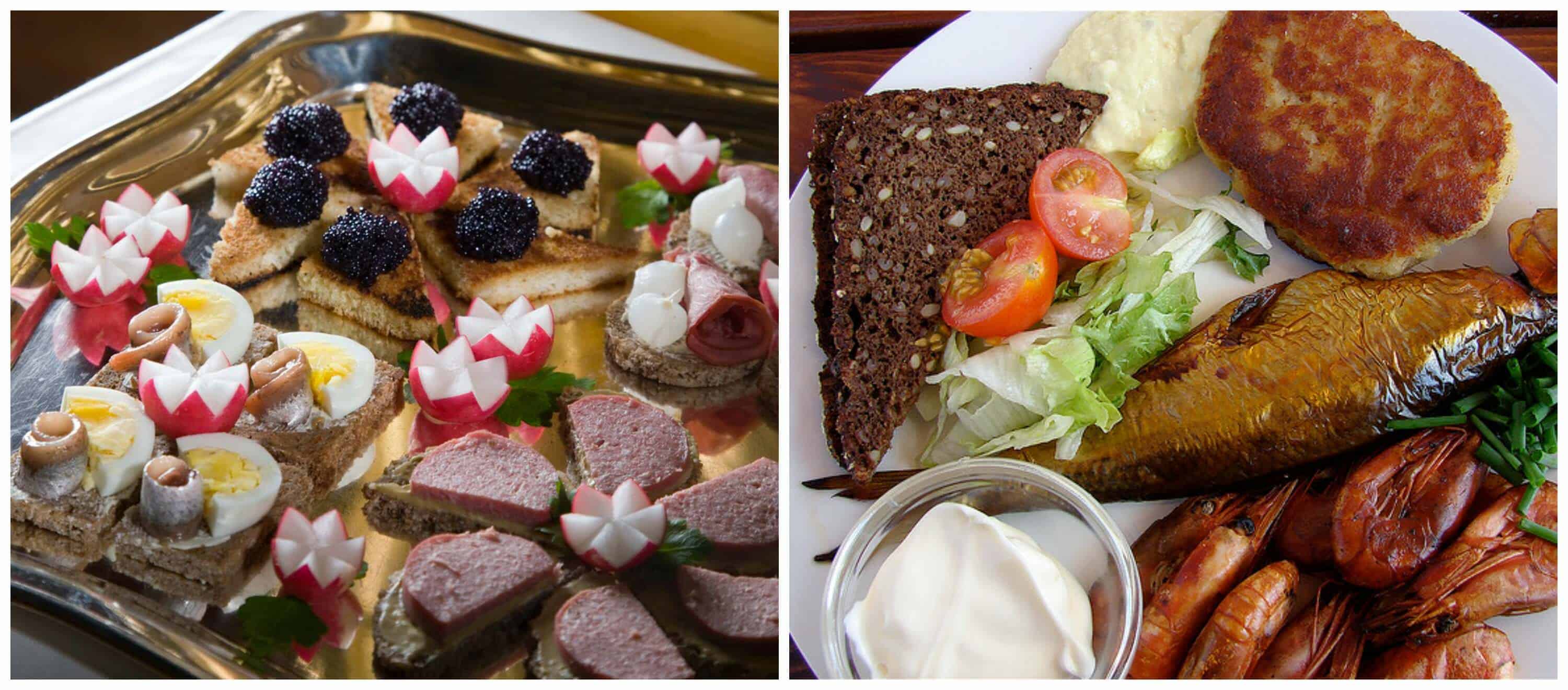
I’ve known many people who have visited Denmark or Germany, fell in love with this type of bread and returned home to their countries unable to find it there. I haven’t been able to find it anywhere here in the U.S. except for German specialty stores and World Market stocks a very small selection of dense German breads. Though specifically Danish sourdough rye bread I haven’t found anywhere here for purchase. The good news is you can make it yourself and I’m going to be posting several recipes for this wonderful style of dense, hearty European bread.
We’re going to start with a favorite among many, Danish Rye Bread. And while this bread is also popular in Germany, it claims particular importance in Denmark, indeed it’s practically one of its national foods, so we’re going to go ahead and ascribe this bread to the Danes. (Plus it will make the maternal side of my husband’s family happy, they’re fiercely proud of their Danish ancestry. And I have some Danish ancestry myself, so we’re all happy.)
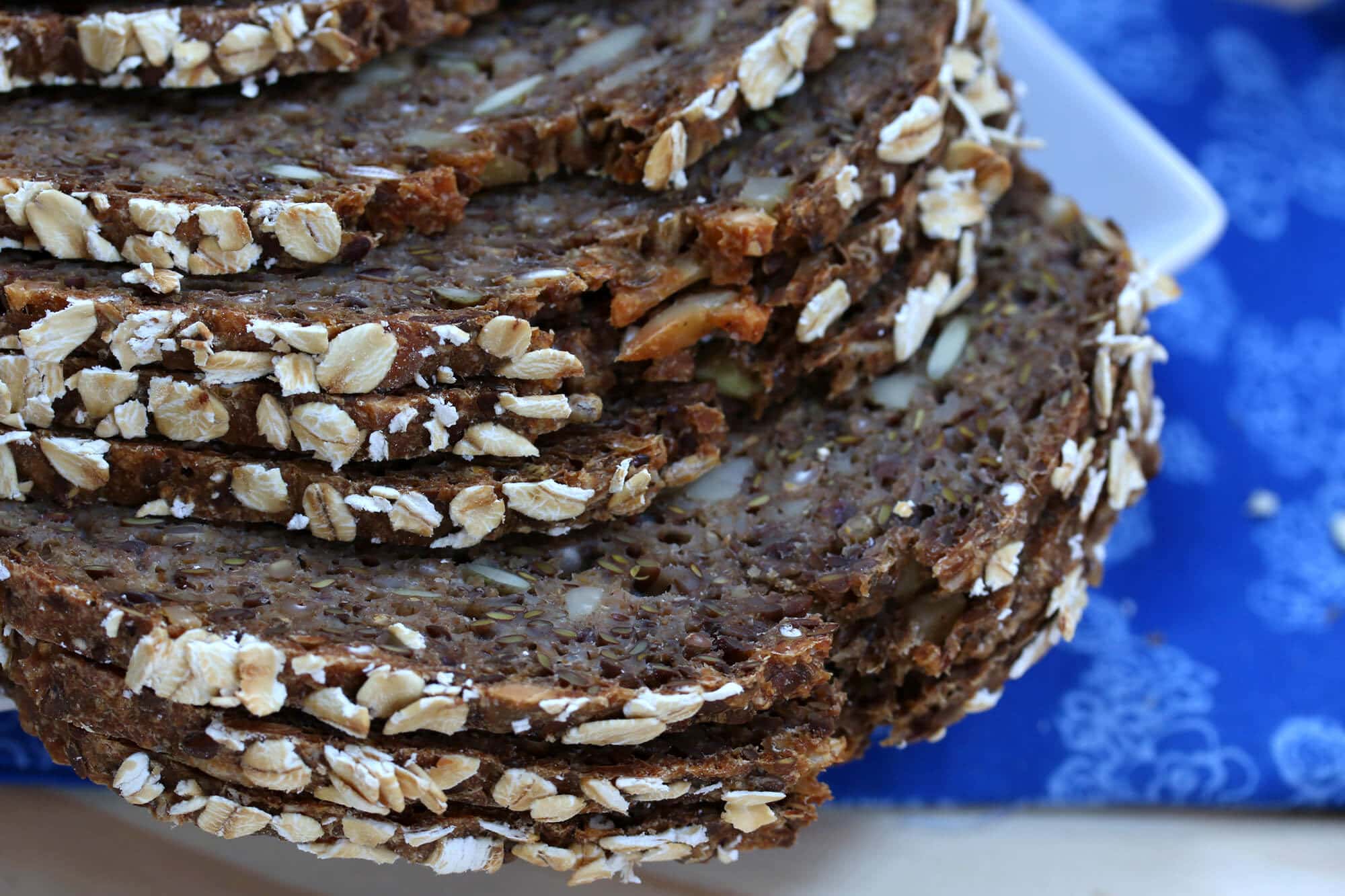
How to Make Danish Rye Bread
Danish rye bread is a sourdough bread that traditionally takes 2-3 days to make. Here is a super simple version that cuts the fermentation time down to as a little as 24 hours without the need to tend and feed it. This version calls for a yeasty beer. Beer and bread are cousins, both traditionally made from the same two ingredients, water and grains. The alcohol in this bread is burned off during the long baking process while the beer contributes to a fabulous texture and consistency (and flavor, depending on which beer you use).
The bread dough is allowed to ferment for 24 hours at room temperature (or 48 hours depending on how sour you like the bread). This fermentation process neutralizes the phytic acid in the grains, a naturally occurring substance that binds nutrients so that the body cannot properly absorb them. Not only does phytic acid acid bind the nutrients of the grains themselves, it binds the nutrients of anything else you eat with the grains. Fermenting the bread dough increases its nutrients and makes the bread easier to digest. And even after sourdough is baked it continues to sour and only gets better in flavor over time.
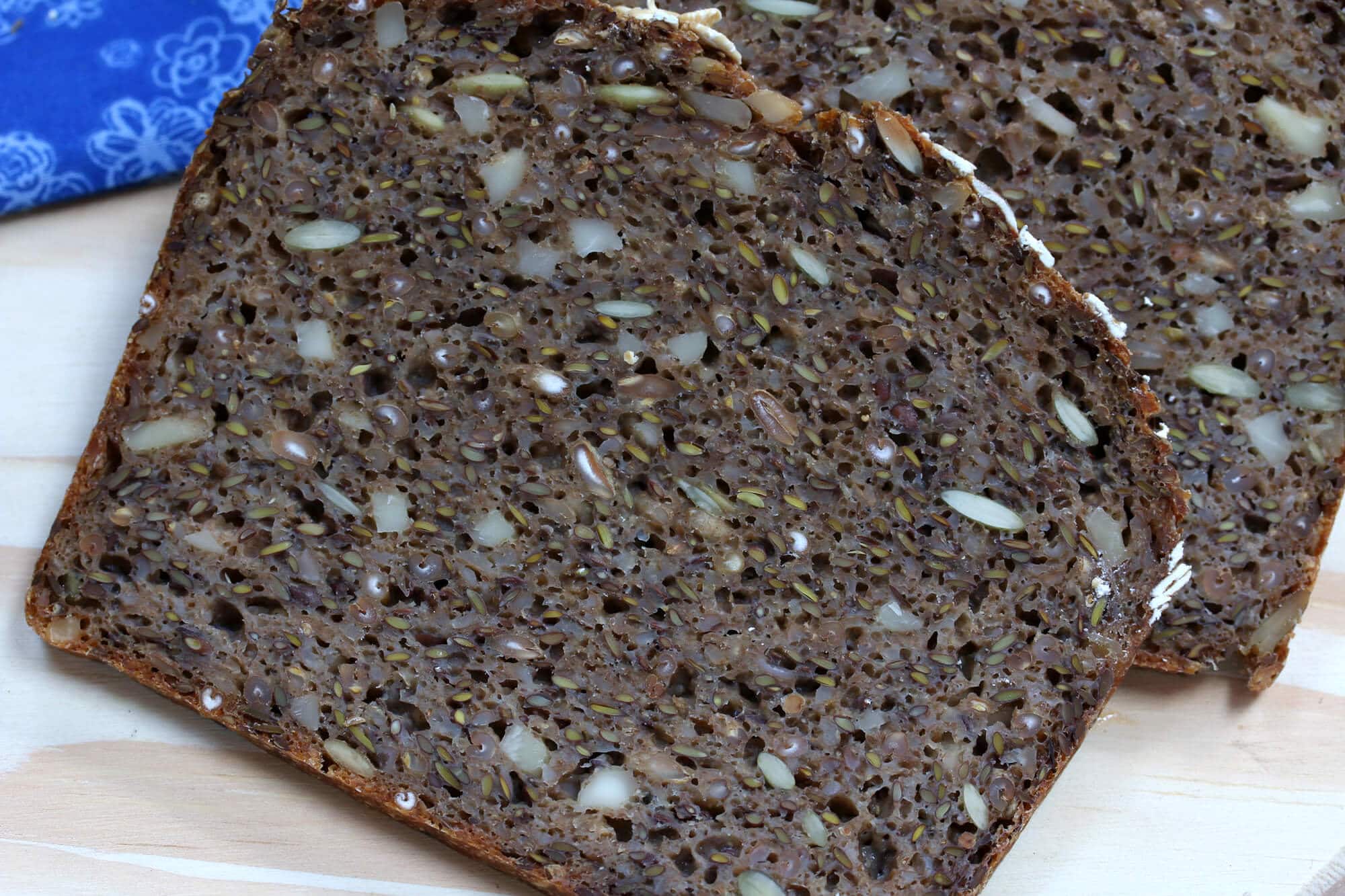
Danish Rye Bread Ingredients
This wonderfully nourishing bread is packed full of whole grains, seeds and nuts. The grains are included in the form of flour (rye and wheat), cracked rye berries and whole rye berries. Tons of similar styled breads incorporate these various forms of whole, cracked, coarsely ground and finely ground grains (eg, spelt, einkorn, wheat, kamut, etc) into the same loaf for a wonderful balance of textures, and that’s where a good grain mill really comes in handy. Not only can you grind your own fresh flour on demand with all the nutrients still intact (as opposed to flour that’s been sitting on grocery store shelves for ages), you can get exactly the kind of grind you need.
I buy my grains all in bulk, take out what I need to last me for a few weeks at a time and store the rest in a dark, cool place. I don’t even buy flour anymore, I grind all of my own flours, cornmeal and make my own baking mixes. For today’s Easy Danish Rye Bread I’m using my German-made KoMo Classic Grain Mill, another stellar example of German engineering and the pride and joy of my kitchen.
With a 12-year warranty, the quality and construction of the KoMo is amazing, plus it’s gorgeous and something you’d want to display on your counter. You can grind your grains as fine or coarse as you like. I use it nearly every day to make my own flours, cornmeal and mixes and cannot recommend it highly enough.
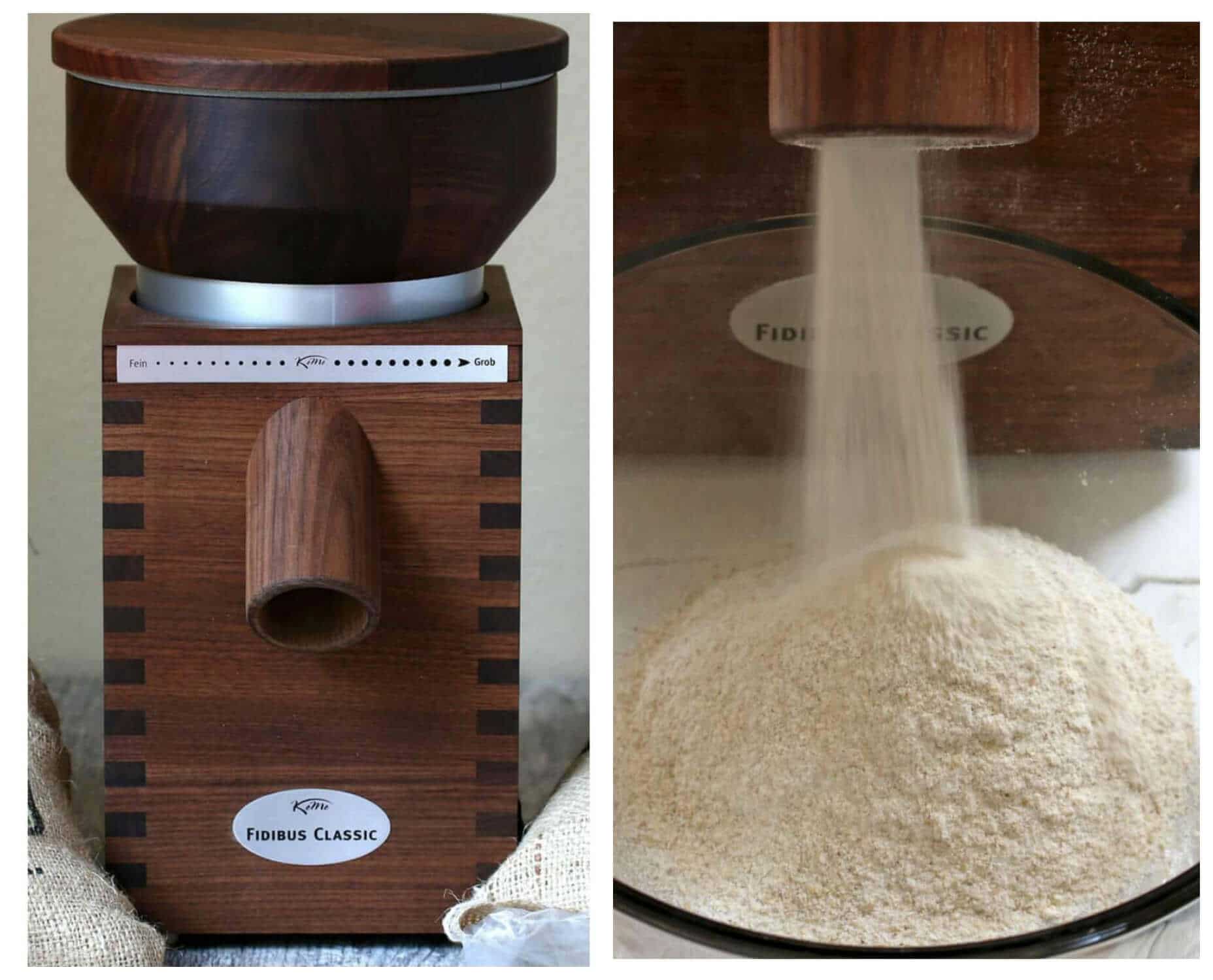
Check out my video below where I talk about some of the KoMo Classic Grain Mill’s features and show it in action in making today’s Danish Rye Bread!
Danish Rye Bread Recipe
Let’s get started!
If you’re grinding your own rye and wheat flour and cracking your own rye berries you’re in great shape! If you don’t have a grain mill you can easily find rye flour in grocery stores and you can “crack” the rye berries yourself by very briefly pulsing them in a good/powerful blender or food processor or smashing them in a bag with a meat mallet or other heavy object.
Combine all of the dry ingredients in a stand mixer bowl. Stir the yeast and sugar into the warm water and let sit for 10 minutes. Add all the wet ingredients to the dry ingredients.
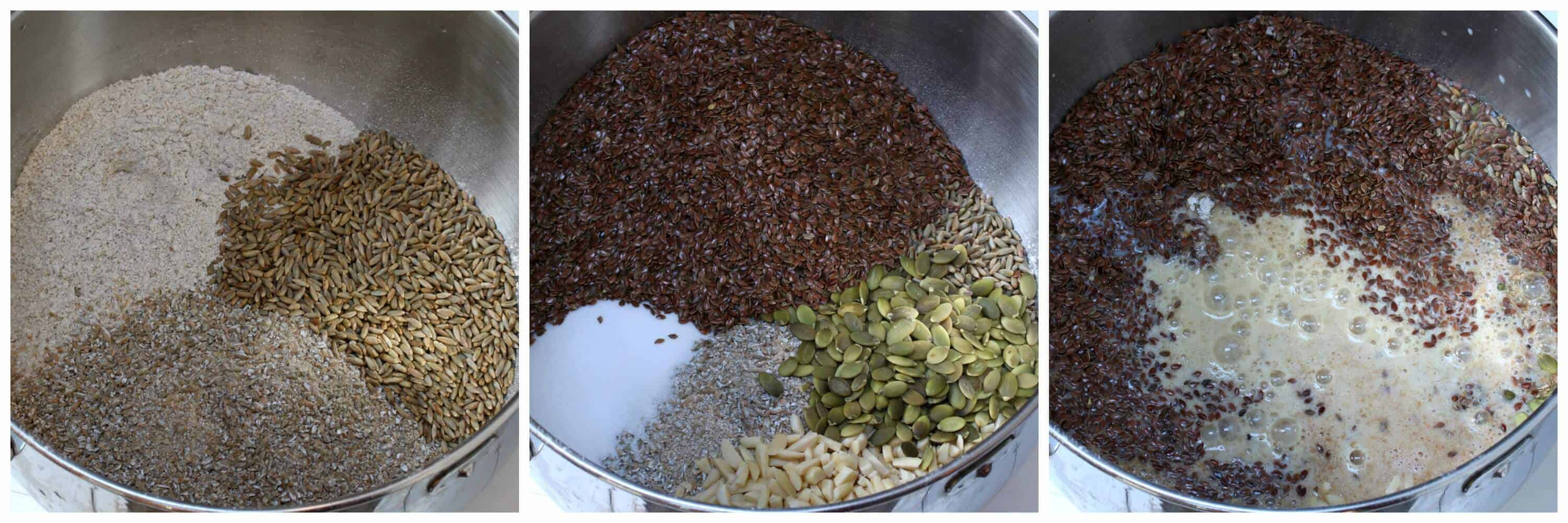
Give everything a stir manually to combine, then attach the dough hook on the stand mixer, set it to the bread setting (#2), and knead for 10 minutes. The dough will be very sticky, loose and not remotely malleable (ie, incapable of being shaped).
Scoop the dough into a very large non-metallic bowl. The dough will bubble up so use a very large, deep bowl with plenty of head room. Cover the dough loosely with plastic wrap and set it in a warm place (ie, room temperature) for 24-48 hours, depending on how sour you want the bread. I’ve done both with great results. If you’re only letting it ferment for 24 hours we recommend first soaking the whole rye berries overnight before using them (drain thoroughly).

After 24 hours the dough will be nice and bubbly with a very gooey texture.
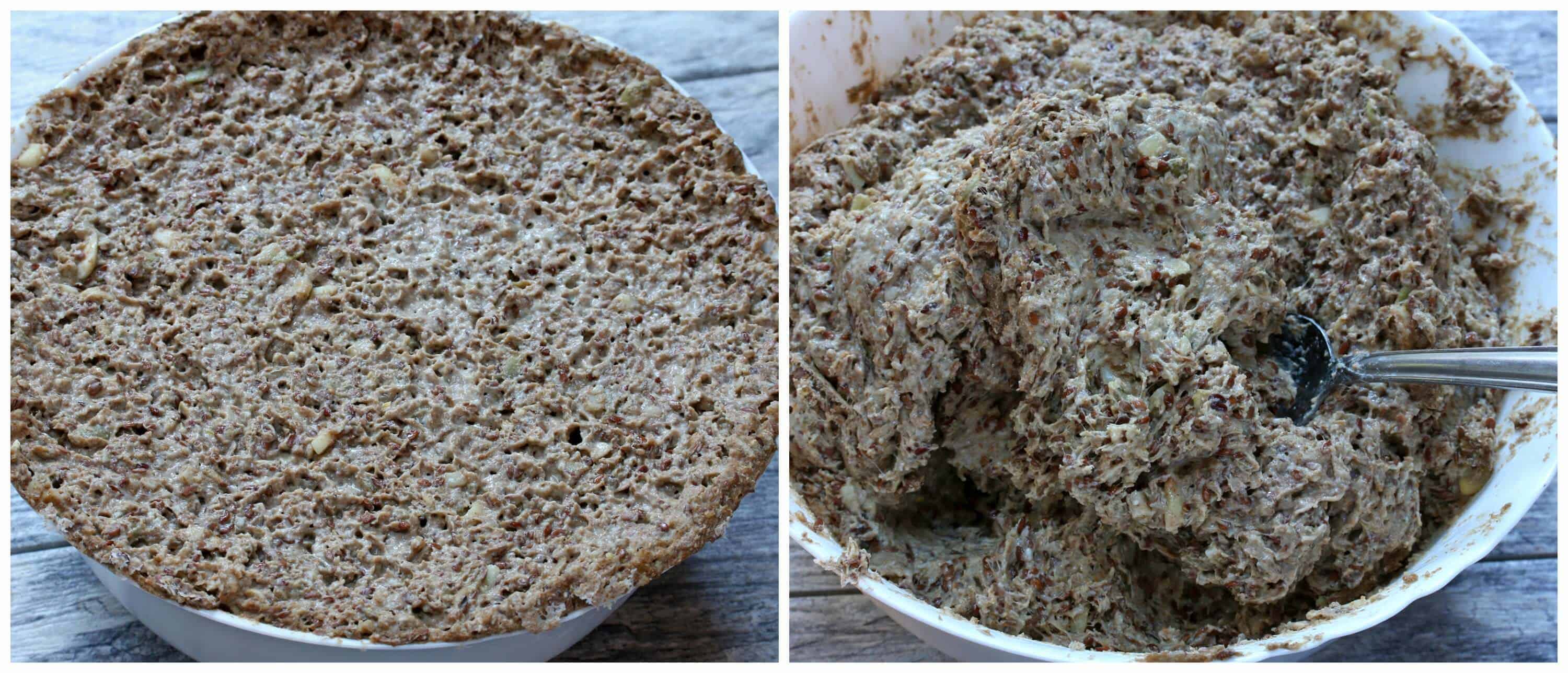
For sourdough it’s recommended that you line your loaf pans so the acid in the dough can’t react with the metal. I use and love the Parrish Magic Line bread pan made of heavy gauge aluminum with straight edges (made in the USA). It’s a 9 x 5 x 3 inch loaf pan.
Scoop all of the dough into the loaf pan, patting it down. It’s a lot of dough but it’ll fit in there, just pat it down (be sure you’re using a 9x5x3 loaf pan). Brush the top with some water and sprinkle some oats evenly over it.

Bake at 350 degrees F for 100-120 minutes or until the center is done. For best and most accurate results use an instant read thermometer and aim for an internal temperature of at least 210 degrees F.
Let it sit for 5 minutes before removing it from the pan. Let the bread cool completely before slicing it. Your rugbrod is ready!
To prolong its shelf life I recommend storing it in the refrigerator or freeze part of it if you know it will take you a while to go through it.
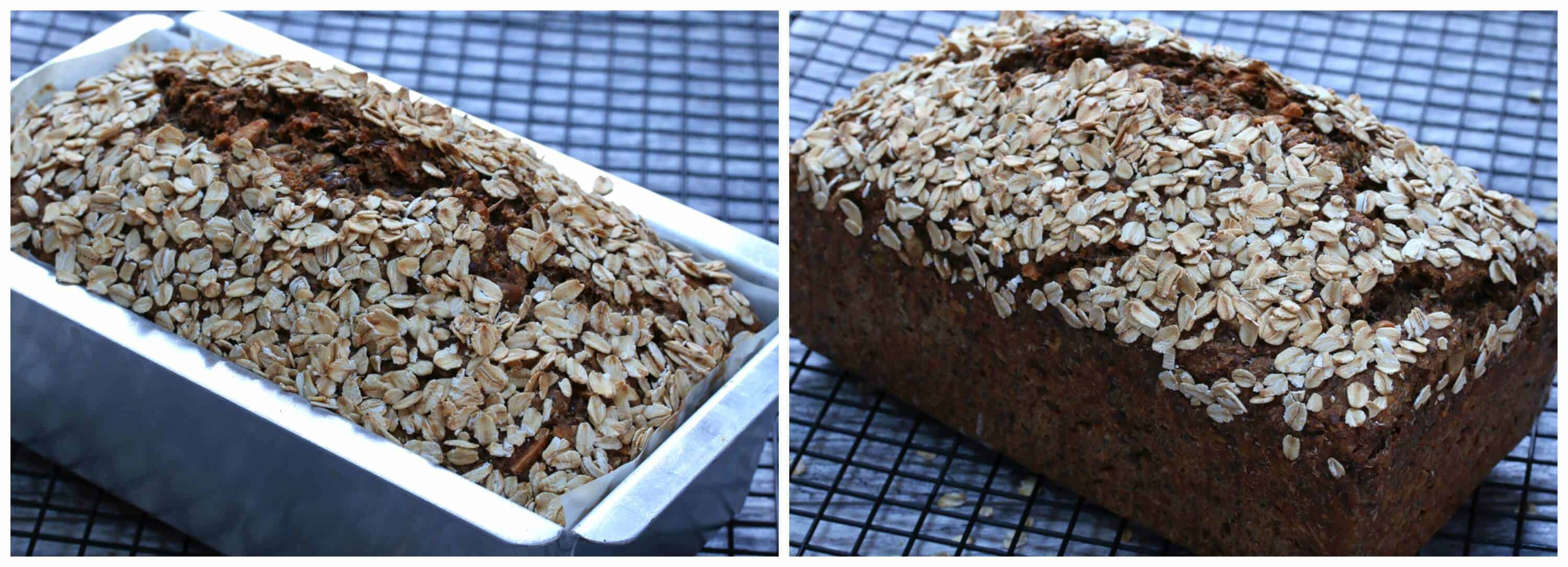
In order to get nice thin, clean slices that look like something you bought at a professional bakery, I recommend a slicer. Chef’s Choice Slicers are consistently ranked at the top and they get excellent reviews. I also use a slicer for meats and cheeses. Whenever I find chunks of cooked ham, turkey or cheese on sale I get those and slice them myself – it’s cheaper than buying them at the deli. At the very least you’ll need an excellent bread knife and for that my favorite knife, hands down, is the Cutco 9 3/4″ Slicer. It glides smoothly through bread and meat like no other.
Enjoy!
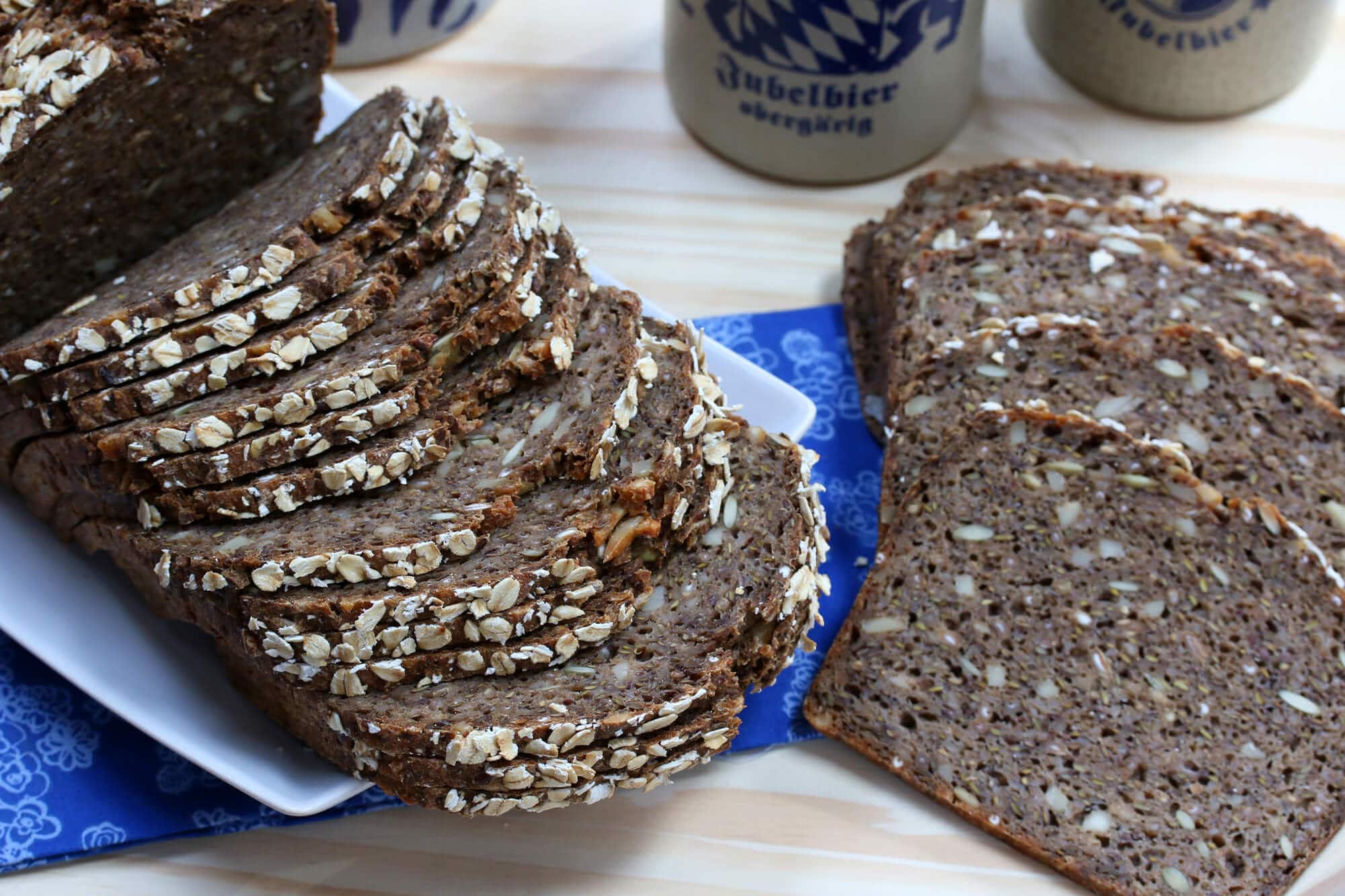
For more delicious breads from around the world be sure to try my:
- German Bread (Vollkornbrot)
- Lavash
- Injera
- Dosa
- Naan Bread
- Sourdough Naan
- Sourdough English Muffins
- Crumpets
- Olive Rosemary Focaccia
- Skillet Cornbread
Save This Recipe
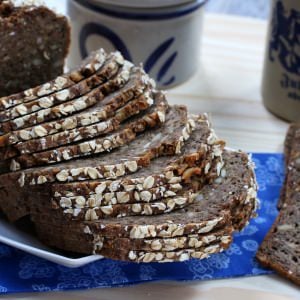
Danish Rye Bread (Rugbrød)
Ingredients
- 2 cups lukewarm water
- 2 teaspoons dry active yeast
- 2 tablespoons sugar
- 2 1/2 cups dark rye flour
- 3/4 cup all-purpose flour
- 1 3/4 cup cracked rye berries (very briefly pulse whole rye berries in a strong blender or food processor until they're broken up into coarse pieces OR smash them in a heavy duty bag with a meat mallet or other heavy object)
- 1/2 cup whole rye berries
- 1 1/4 cup whole flaxseeds
- 1 1/3 cup sunflower seeds or combination of sunflower seeds ,pumpkin seeds and/or chopped almonds
- 3 teaspoons salt
- 1 cup dark beer (see note)
- 1 cup buttermilk or kefir (vegan: 1 cup almond milk mixed with 2 tablespoons cider vinegar) (I often use homemade kefir in place of buttermilk)
- Traditional rolled oats for sprinkling
Instructions
- Stir the yeast and sugar into the lukewarm water and let sit for 10 minutes until the yeast is frothy.
- Combine all the dry ingredients in the bowl of a stand mixer. Add the yeast mixture, beer and buttermilk. Stir to combine.Fit the stand mixer with a dough hook and knead on the bread setting ("2") for 10 minutes. The dough will be very sticky, loose and not remotely malleable (ie, incapable of being shaped).Scoop the dough into a very large non-metallic bowl with plenty of head space (the dough will bubble up). Cover loosely with plastic wrap and let it rest in a warm place (room temperature) for 24-48 hours, depending on how sour you want the bread to be (be sure to ferment it for at least 24 hours to ensure enough of the liquid is absorbed). If you're only letting it ferment for 24 hours we recommend first soaking the whole rye berries overnight before using them (drain thoroughly).
- Line a 9x5x3 inch bread loaf pan with parchment paper (SEE NOTE). Preheat the oven to 350 degrees F.Scoop all of the dough into the lined bread pan, pressing down as needed. (It's a lot of dough but it will fit.) Brush the top with water and sprinkle over evenly with the rolled oats.Bake on the middle rack for 100-120 minutes or until the center is done. For best and most accurate results use an instant read thermometer and aim for an internal temperature of 210 degrees F.Let the loaf cool for 5 minutes before removing it from the pan. Let the loaf cool completely before slicing. Keep stored in an airtight container. To prolong its shelf life I recommend storing it in the refrigerator or freeze part of it if you know it will take you a while to go through it.
Notes
* You can substitute water or more buttermilk for the beer
Nutrition
Originally published on The Daring Gourmet January 28, 2016

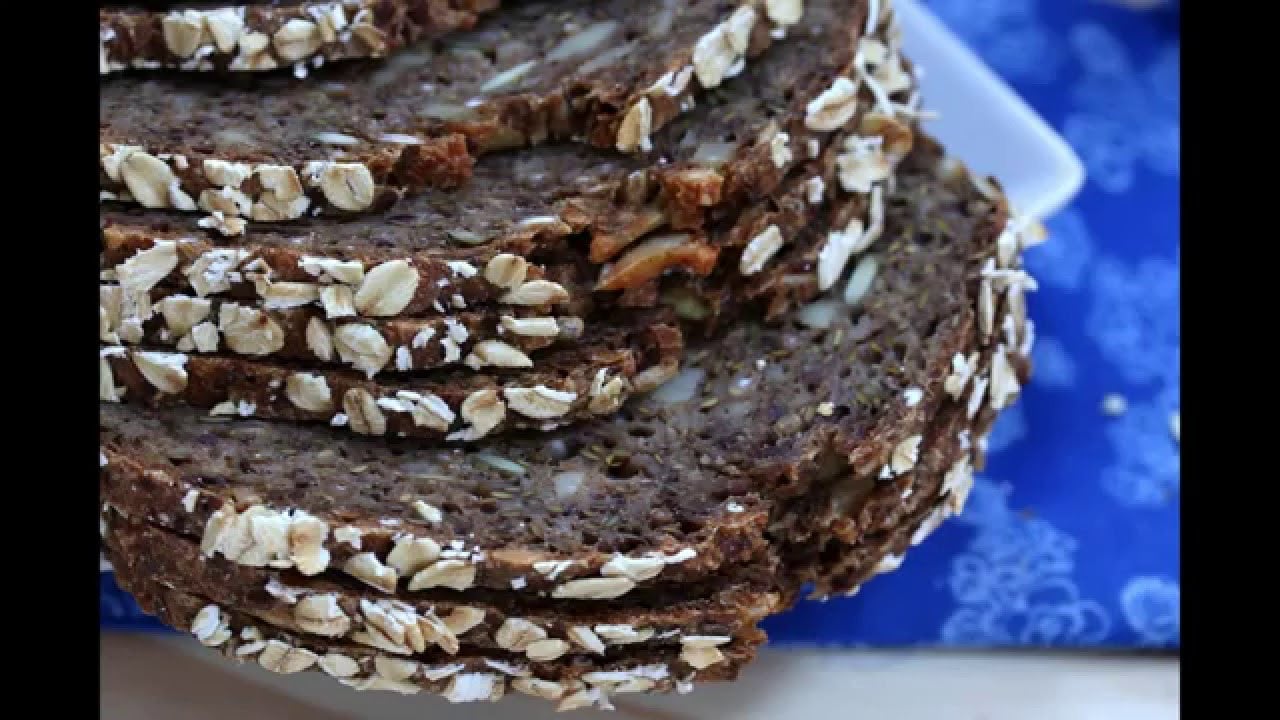


















Hiya! I am lactose intolerant. I brew my own kombucha, could you use kombucha instead of kefir?
Hi Yasha, yes you can. Happy baking!
Hi Kimberly:
Do you soak your rye berries prior to using them? I don’t want to bake only to find out I should have soaked them before using! And in the absence of cracked rye berries, can I run some whole rye berries through the food processor to get “cracked” ones?!
Thanks,
Shelley
Hi Shelley, no there’s no soaking involved. And absolutely, cracking them in the food processor is perfect. Happy baking!
Hi Kimberly,
I’m all set, have mixed the dough and just starting the 48 hour rise time. The apartment is cold (I’m in NYC) so I wonder if I should leave it to rise for longer than 48 hours? usually when making wheat breads for which the recipe says 30 mins for a rise time I’ve had to give it a couple of hours before it reached the height indicated in those recipes. I’ve put it inside the oven for now where I believe the pilot light keeps the interior a tiny bit warmer than the rest of the house.. I think! Any ideas?
I split the dough into two glass bowls for the rise as I didn’t have one that was big enough for all the dough with extra room. I hope that doesn’t do any occult magic physics thing to ruin the rise. Also, I’m concerned all the dough wont fit in a 9x5x3 pan.. which I know you say it will.
I’m wondering, for future: can I halve the recipe and just make a smaller bread? would be nice to give a smaller version as a gift so it’s not too much to have to take care of. I’d bake it in the same loaf pan. do you think it would work? would i reduce the baking time?
Excited, but also scared reading all the replies here from folks whose bread didn’t bake fully.
Thanks so much.. this was the most promising recipe on the internet for this kind of bread without a starter! I know I would never be trying to make it if it weren’t for the active dry yeast version, so thank you again for making it accessible to novices such as me!
Hi Zahra! I think the dough will be fine in your oven for 48 hours and having divided the batter should be fine as well. I know it seems like a lot of batter for that loaf pan, but this bread doesn’t rise much – it’s very dense. Yes, you can divide the batter and bake two smaller loaves but I would recommend using two smaller loaf pans or you’ll end up with flat bread. The best way to make certain the bread is fully baked is to use an instant read thermometer like I mentioned in the post. That way there’s no risk of under-baked bread. But I realize it can be a hassle for some to get one, especially if you don’t do a lot of bread baking and don’t otherwise have much use for a thermometer. In any case, I hope you’re first attempt at this bread is a success – let us know how it goes!
hi,
so my dough stiffened quite a bit during the rise time; i had to break it up and practically coerce the pieces into the loaf pan!
I did sub the cup of beer and used a cup of buttermilk instead (so two total cups of buttermilk), so maybe that was to blame? I measured everything else out exactly.
I baked it for 100 minutes and then took it out as there was no way for me to measure internal temperature. Even so, the bread was quite hard. It took me almost 2 hours to slice all of the bread, it was really hard on the outside so a lot of muscle to cut through, and I was using my best knife. I guess this is where the slicer comes in handy.
Every slice would want to fall over and would break off before i had cut all the way down. This happened with all my slices, until I decided to cut the bread in half lengthwise, and cut smaller pieces to avoid the break-offs. even so, i had a hard time getting my slices to stay together! I was cutting a thickness that would offer up 20 slices, so it’s not like my slices were thinner than normal for this kind of bread.
I wonder what went wrong.. I presume not everyone making this bread has a slicer, and if they suffered the same dismay each time they cut a new slice?
Other than that, once all of that was done, i was able to freeze the whole thing, and now toast each slice with a lot of care to prevent further breaking. It is still delicious, and i’ve been enjoying it very much. Though, because I still remember the horror of slicing it, I don’t think I’ll dare make it again, sadly… only because it took so much time and also emotional labor to slice.
Being a Dane I grew up with rye bread Rugbrød. Always the whole grain type.
Now at age 69 I still eat it. I bake at least once a week.
I love the hard crust, with unfortunately turns softer when you store it.
The succulent tasty body. Alway add sunflower seeds and pumpkin seeds.
But I don’t use sugar like you do. The natural sweetness is so rich.
I’m fortunate that the bread mix is readily available in our local supermarket. It evens contains sour dough.
So baking Rugbrød is the simplest thing in the word.
A recent survey shows that up to a third of Danish families bake their own bread. Not only is it much cheaper, but because it tastes so much better.
I just recently starting making the no knead wheat bread in a hot pot in the oven. Again full grain. Just heavenly good. Try it.
We can it the worlds best bread. Of course not including the Rugbrød. Nothing beats that.
Absolutely nothing beats homemade bread fresh out of the oven, Henrik! Whole grain breads are my favorite too but a light and crispy French baguette plays a close second :)
Looking forward to trying this recipe. Do you need to pre-soak or pre-cook the whole and cracked rye berries?
I’m trying to figure out what went wrong in mine. It turned out very bitter—to the point that I had to throw it out! I did look at a couple other recipes that suggested malt syrup so I used a little of that. I also mixed the dark beer with the buttermilk to save space. Could these two additions have ruined it for me? I’ve bought Ikea’s Flerkorn Brödmix before, and it is delicious and I wanted to recreate it. This didn’t come close, but I want to know what went wrong…
Hi Susan, that’s a very typical amount for rugbrød but of course personal tastes will always vary.
Hi Kim, thanks for replying to my question about the yeast, it helped tremendously. I have just pulled the product from the oven it was not successful :( So, here’s what happened. After the two hour mark my instaread was only at 200 so I let the bread sit.. and sit.. and sit, and 20+ extra minutes had gone by and the internal temp had only gone up 1 degree to 201. At this point the oats on top were beginning to brown and the smell of “burnt” was in the kitchen. So I took the bread out, let it rest, do its thing, and when I sliced in to it the crust was very hard, the parchment paper was completely sealed to the bread, and the inside was very gooey. In the BBQ world when you’re smoking meat there is a “stall” at 160 degrees and there are ways to “push” through it. Is there a technique to get the internal temp up to 205 without going over the 2 hour mark and burning the bread? Thanks
Hi Eric, thanks for the feedback and I’m sorry to hear your bread didn’t turn out this time. That’s bizarre that the temperature only went up by one degree after over 20 minutes. What kind of loaf pan are you using? I’m not aware of a stalling point when it comes to baking. In any case, next time I would suggest that once your bread reaches the point where it’s light brown on top but the center still isn’t up to temperature, cover it with aluminum foil for the rest of the baking time. That will not only prevent the top from burning before the center is done, it will also help trap in the heat. Also, you can very lightly spray the parchment paper with some oil.
Thank for getting back to me so quickly! I will do as suggested for tomorrows bake and will let you know how it turned out. My bake pan is a very standard, a Wilton 9x5x3. Should I use something more commercial?
No, that pan will do the job. Also, if you didn’t already do this, be sure to bake the bread on the middle rack so it’s not too close to the top burners. I hope you have better luck this time, let us know!
Hi Kim, great recipe. However, I’m having an issue getting my yeast “frothy.” Should this be “proofed” all the way until it’s bubbling or should there be a thin later if foam on top, my results are the latter. All the proofing videos I’ve seen used far less water. What exactly am I looking for? Thank you.
Hi Eric, that extent of proofing isn’t necessary for this, a thin layer of froth on top is sufficient. Happy baking!